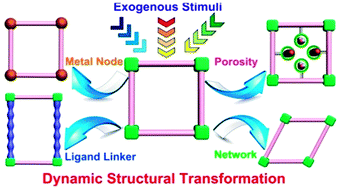Dynamic structural transformations of coordination supramolecular systems upon exogenous stimulation
Abstract
Reactions in the solid state, especially single-crystal-to-single-crystal (SC–SC) transformations, provide an appealing pathway to obtain target crystalline materials with modified properties via a solvent-free green chemistry approach. This feature article focuses on the progress to date in the context of coordination supramolecular systems (CSSs), especially coordination polymers (CPs) or metal–organic frameworks (MOFs), which show interesting dynamic natures upon exposure to various exogenous stimuli, including concentration, temperature, light and mechanical force, as well as their synergic effect. In essence, dynamic CSSs normally possess crucial crystalline-reactive characteristics: (i) metal ions or clusters with unstable or metastable electronic configurations and coordination geometries; (ii) organic ligands bearing physicochemically active functional groups for subsequent reactions; (iii) polymeric networks of high flexibility for structural bending, rotation, swelling, or shrinking; (iv) guest moieties to be freely exchanged or eliminated by varying the environmental conditions. The significant changes in catalytic, sorption, magnetic, or luminescent properties accompanied by the structural transformations will also be discussed, which reveal the proof-of-concept thereof in designing new functional crystalline materials.



 Please wait while we load your content...
Please wait while we load your content...